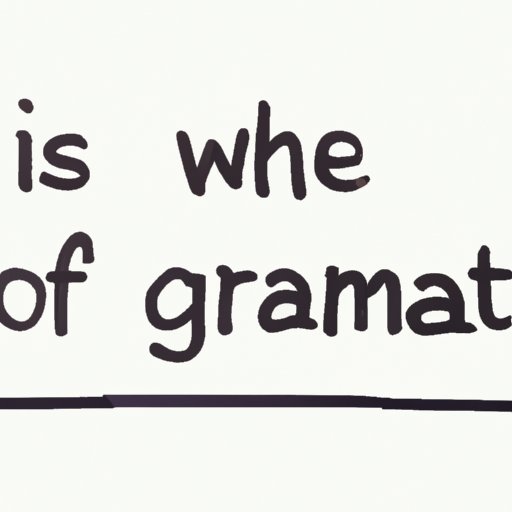I. Introduction
Mastering the English language can be tricky, especially when it comes to grammar. One area that often confuses writers and speakers alike is the use of ‘which’ versus ‘that’. Whether you’re a budding writer or simply interested in improving your language skills, understanding the differences between these two words is essential for clear and effective communication.
II. Mastering the Grammar Puzzle: A Guide to Understanding Which vs. That
Before delving into the rules and best practices of using ‘which’ and ‘that’, it’s important to have a basic understanding of their meanings.
‘Which’ is a pronoun used to refer to things or groups of things. It is often used to introduce non-essential, or non-distinguishing, information in a sentence.
‘That’, on the other hand, is also a pronoun used to refer to things or groups of things. However, it is usually used to introduce essential, or distinguishing, information in a sentence.
The key to understanding the differences between the two lies in the meaning and structure of the sentence itself.
III. Navigating the Which vs. That Dilemma: Tips for Clear and Effective Writing
When determining whether to use ‘which’ or ‘that’ in a sentence, there are a few key factors to consider.
The first is to identify the subject of the sentence. This will help you determine whether the information being introduced is essential or non-essential.
Once you have identified the type of clause you are dealing with, it’s important to understand how to use ‘which’ and ‘that’ in each situation.
If you are introducing non-distinguishing information, it is appropriate to use the word ‘which’ and separate it from the rest of the sentence with a comma.
If you are introducing distinguishing information, it is appropriate to use the word ‘that’ and not add a comma.
IV. The Definitive Guide to Choosing Between Which and That in Your Sentences
Understanding the difference between restrictive and non-restrictive clauses is essential in deciding which word to use.
A non-restrictive clause offers additional information that is not essential to the overall meaning of the sentence. It is typically introduced with the word ‘which’ and separated from the rest of the sentence with a pair of commas.
For example, “The tree, which was tall and majestic, swayed in the breeze.”
A restrictive clause, on the other hand, is essential to the meaning of the sentence. It is typically introduced with the word ‘that’ and not separated from the rest of the sentence.
For example, “The book that I read last night was amazing.”
V. Which or That? Understanding the Rules and Exceptions for Correct Usage
While the basic rules for using ‘which’ and ‘that’ are fairly straightforward, there are some exceptions to keep in mind.
One common exception occurs when using ‘which’ in a restrictive clause. This is generally considered incorrect grammar. However, there are some cases where it is acceptable to use ‘which’ in a restrictive clause, such as when the sentence is particularly complex or attempting to clarify a point.
Similarly, there are some situations where ‘that’ can be used in a non-restrictive clause, such as when the comma would make the sentence awkward or unclear.
VI. Writing with Confidence: How to Use Which and That Like a Pro
The best way to become proficient in using ‘which’ and ‘that’ is through practice.
Start by reading sentences and practicing identifying whether the clause is non-restrictive or restrictive. Then, practice using ‘which’ and ‘that’ in both types of clauses.
It’s also important to remember that while grammar is essential, it’s not the be-all and end-all of writing. Don’t let a fear of grammar mistakes hold you back from expressing yourself creatively and confidently.
VII. The Which vs. That Conundrum: Common Mistakes to Avoid in Your Writing
Even the most skilled writers sometimes make mistakes when it comes to grammar. Here are a few of the most common mistakes to avoid when using ‘which’ and ‘that’:
- Using ‘which’ in a restrictive clause
- Using ‘that’ in a non-restrictive clause
- Overusing either word in your writing
By being aware of these mistakes and consciously working to avoid them, you can improve the clarity and professionalism of your writing.
VIII. Conclusion
In conclusion, understanding the difference between ‘which’ and ‘that’ is an essential skill for any writer or communicator. By identifying the subject of your sentence and the type of clause you are using, you can determine which word to use and ensure that your writing is clear, effective, and grammatically correct.
Remember, practice makes perfect, so don’t be afraid to practice using ‘which’ and ‘that’ in your writing. With a little effort and attention to detail, you can master this common grammar puzzle and confidently communicate your ideas to others.
